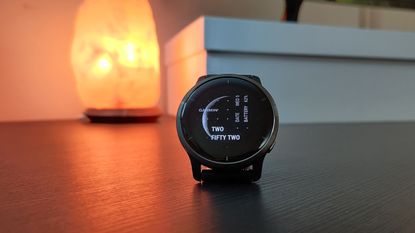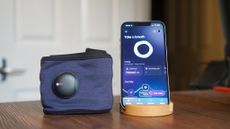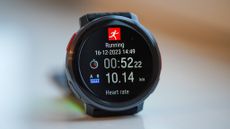Garmin Venu 2 review TL;DR: Best Garmin watch for fitness smartwatch that's actually enjoyable to use and looks awesome too. Better still, the Venu 2 has an impressive battery life for an AMOLED watch.
I liked the original Garmin Venu and enjoyed using the Garmin Venu Sq, but admittedly, none of them got me really excited. However, when I first read about the Garmin Venu 2, I instantly knew this would be a different smartwatch. It looked stunning, promised long battery life and a sharp and responsive screen. And you know what? It is an amazing fitness watch.
Being a big fan of running watches, I was a bit apprehensive when I started testing the Venu 2: I can't possibly like a fitness smartwatch!? Is it going to make me look like a filthy casual? But after wearing the Venu 2 for a couple of weeks, I had to come to the realisation that I actually really liked this watch.
What follows is the story of how I fell in love with the Garmin Venu 2.
- RELATED: Garmin Venu 2 vs Venu 2 Plus - Which fitness smartwatch should you get?
Garmin Venu 2: price, availability and what's in the box
The Garmin Venu 2 comes in two different sizes: the larger Venu 2 has a 45 mm watch case with a 22 mm band and the smaller Venu 2S is a 40 mm watch case with an 18 mm band.
Both Garmin Venu 2 versions have the same suggested retail price which is $399.99/£349.99/AU$629 and are available now at Garmin US, Garmin UK and Garmin AUS.
In the box, you'll find the watch itself, a user guide and a charging cable.
Garmin announced the third Venu 2 Plus model in January 2022, the Garmin Venu 2 Plus, which adds voice assistant functionality to the already excellent Venu 2 and Venu 2S. The Venu 2 Plus has a 43 mm watch case and a 20 mm band.

Garmin Venu 2 review: build quality and battery life
The Garmin Venu 2 is a tough wearable. Maybe not quite as rugged as the Garmin Fenix 6 Pro or the Garmin Enduro, but then not many watches are and most importantly, not many watches need to be. Of course, this doesn't mean the Venu 2 isn't made of quality materials.
The 1.3" AMOLED touchscreen display has a 416 x 416 pixels resolution, and it even has an optional always-on mode. Needless to say, turning this on will significantly impact battery life, and not in a positive way. The display is protected by Corning Gorilla Glass 3 lens, which is encased in stainless steel bezel. The case is made of fibre-reinforced polymer, similarly to many other Garmin watches, including the Garmin Forerunner 945 and the Garmin Forerunner 745. The case is water-rated to 5ATM.
The strap is made of a "structured" silicone material. Well, it's structured on the outside but also pretty smooth on the inside, so you can wear it without rubbing on your skin. The straps are industry-standard 22mm quick release bands, so feel free to swap it out to a different one if you fancy. The Garmin Venu 2 weighs 49 grams, not the lightest watch – compare it with the Coros Pace 2's 29 grams – but it won't weigh your arms down at all.
All things considered, the Garmin Venu 2 is well protected from the elements.
Battery life is a category the Garmin Venu 2 really excels in. Officially, the Venu 2 has an 'up to' 11 days battery life in smartwatch mode, that's if you don't have GPS on. GPS battery life is 22 hours, 8 hours if you listen to music while tracking outdoor activities.
Now, this might not sound amazing, but this is an AMOLED smartwatch, and those devices tend to have a battery life of a day or two, max. Even when compared to hardcore running watches, like the aforementioned Forerunner 745, the Venu 2 still performs better. The Forerunner 745 has up to 16 hours of battery life in GPS mode and a mere 6 hours in GPS plus music mode.
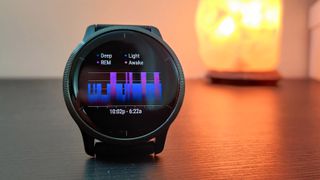
Garmin Venu 2 review: features and sensors
The Garmin Venu 2 offers many familiar features we've seen in previous Garmin watches, plus some new ones. I'm sure other Garmin wearables will get at least some of these features later on, but for now, they are specific to the Venu 2.
As well as the new sport modes (more on these below), the Venu 2 has the new Health Snapshot feature, which is supposed to provide you with just that: a snapshot of your health metrics, including heart rate, SpO2, respiration and stress levels as well as heart rate variability estimations. All you have to do is sit still and let the Venu 2 measure this. I personally didn't see a point in this feature because you can check all this anyway at any point on the watch or in the Garmin Connect app, but anyway, it's available.
Body Battery is back too, and this time around, it's actually somewhat precise, thanks to the Firstbeat Analytics algorithm. Granted, it's still not a medical measurement of energy levels, but at least now, poor sleep doesn't always replenish the Body Battery as it used to. The Garmin Venu 2 also measures stress levels, respiration, blood oxygen and sleep too, all with relatively good accuracy (from what I can tell). Fitness age estimations also seem to be more accurate; gone are the days when my watch said my fitness age was 15 years younger than my actual age (sadly).
Sensor-wise, the Garmin Venu 2 is the first watch to feature the new Elevate v4 heart rate sensor, which now has a few extra LEDs to more accurately tell if the watch is actually on your wrist or not. Thankfully, it works pretty well, and as long as you take the watch off, it'll stop displaying heart rate levels, unlike previous-gen Garmin watches.
Heart rate measurements during workouts seem to be accurate, too: I tested it against the Polar Verity Sense heart rate monitor, and the averages were close enough. The Venu 2 picks up GPS signal pretty darn fast, and the accuracy of the chip is excellent too. I haven't experienced any glitches on this front.
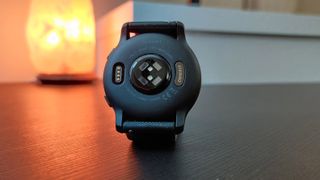
Garmin Venu 2 review: activity tracking and precision
There were some solid claims about new workout modes in the original press release about the Garmin Venu 2. Muscle maps! New bouldering mode! New indoor climbing mode! New and improved HIIT workout profile! And while all of these are present, not all of them are as useful as they first seem.
Let's start with what I was most excited about: muscle maps. The Garmin Venu already had on-screen workout videos, something the Venu 2 inherited. Still, this time around, you can also access a thing called 'muscle map', a graph that shows which muscles are worked during your resistance training sessions.
First of all, from what I can tell, these muscle maps are only available when you load pre-made workouts onto the Venu 2 from the Garmin Connect app. Secondly, the map doesn't show how much each muscle group actually worked; it only tells you which muscles are worked when you do a certain workout. The graph is an aggregate view of all the muscles worked in a workout based on the exercises included.
So muscle maps are only helpful for people who don't know that push-ups work the pecs most, but other new features are slightly better.
The new HIIT workout mode has a 'free' mode where the Venu 2 tracks heart rate and calories burned. Still, you can also download pre-made HIIT workouts from the Garmin Connect app and use the Venu 2 as a HIIT timer for EMOM, AMRAP and Tabata workouts, which is pretty neat.
As for the new bouldering mode, you can set a grading system, so the watch knows how difficult the wall you're about the ascent. For example, you can tell the Venu 2 you're scaling a V4 wall if you prefer the V-scale or if you prefer the Dankyu system, a 7 kyuu wall. It's similar to setting pool length in pool swimming mode.
More traditional sport modes, such as running or cycling, are as detailed as you'd expect from a Garmin watch. Not all details are available to view on the watch, though, but displayed in the Garmin Connect app.

Garmin Venu 2 review: verdict
The Garmin Venu 2 might not provide its users with industrial amounts of training data, but the features it offers will be plenty good enough for many people. Come to think of it, you aren't really missing out on much compared to entry-level and mid-range running watches, especially if you don't mind checking your metrics in the Garmin Connect app.
The AMOLED screen brings the Garmin OS's widget view to life and all the milestone animations, like when you hit your step goals, look way better as animation on the pretty screen. I'm usually not the biggest fan of touchscreen wearables, but I'll make an exception for the Venu 2 as it works really well here.
Not all new features are mind-blowing, but some of them are pretty interesting. Especially considering that these extra features were added on top of the existing features, of which there were plenty already, you really can't complain about getting more bang for your bucks.
Speaking of price: the Garmin Venu 2 is not a particularly cheap watch, although it's way cheaper than the Montblanc Summit Lite or a little cheaper than the Casio G-Shock GBD-H1000, none of which are better watches than the Garmin Venu 2 (they aren't too bad, though).
If you aren't keen on having a dedicated sports wearable wrapped around your wrist and appreciate a good looking smartwatch that has actually useful health and fitness features, you'd be silly not to give the Garmin Venu 2 a go. From now on, it'll be my preferred fitness smartwatch for sure.
Garmin Venu 2 review: also consider
The Suunto 7 offers a similar user experience to the Garmin Venu 2, and Suunto has been busy updating its Wear OS watch since it was originally released in early 2020. It has a way shorter battery than the Venu 2 but has a cool 'running heatmap' screen, which is neat.
The Polar Vantage M2 is cheaper than the Venu 2 and caters for more sporty people (it's a tri watch, after all). It hasn't got a touchscreen, and the Polar Flow app could use a bit of TLC too, but the Vantage M2 is still worth considering when buying a new fitness wearable.

